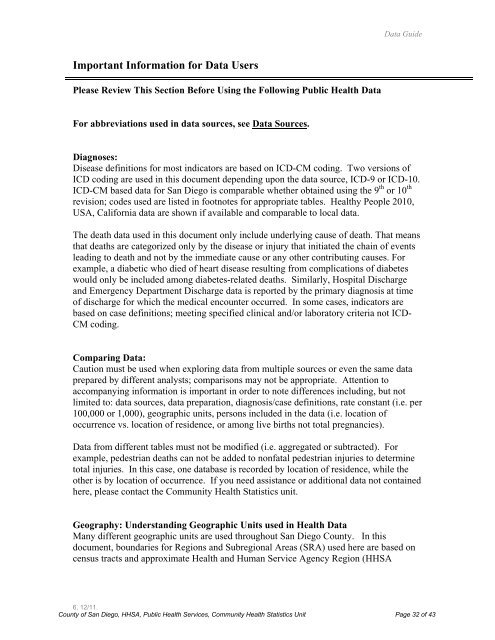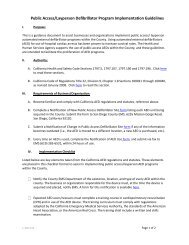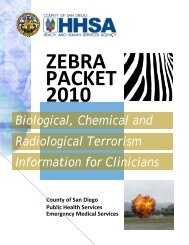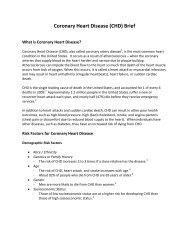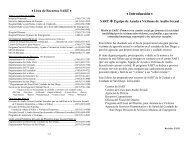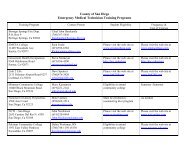County of San Diego Community Profiles North Central Region Profile
County of San Diego Community Profiles North Central Region Profile
County of San Diego Community Profiles North Central Region Profile
Create successful ePaper yourself
Turn your PDF publications into a flip-book with our unique Google optimized e-Paper software.
Data Guide<br />
Important Information for Data Users<br />
Please Review This Section Before Using the Following Public Health Data<br />
For abbreviations used in data sources, see Data Sources.<br />
Diagnoses:<br />
Disease definitions for most indicators are based on ICD-CM coding. Two versions <strong>of</strong><br />
ICD coding are used in this document depending upon the data source, ICD-9 or ICD-10.<br />
ICD-CM based data for <strong>San</strong> <strong>Diego</strong> is comparable whether obtained using the 9 th or 10 th<br />
revision; codes used are listed in footnotes for appropriate tables. Healthy People 2010,<br />
USA, California data are shown if available and comparable to local data.<br />
The death data used in this document only include underlying cause <strong>of</strong> death. That means<br />
that deaths are categorized only by the disease or injury that initiated the chain <strong>of</strong> events<br />
leading to death and not by the immediate cause or any other contributing causes. For<br />
example, a diabetic who died <strong>of</strong> heart disease resulting from complications <strong>of</strong> diabetes<br />
would only be included among diabetes-related deaths. Similarly, Hospital Discharge<br />
and Emergency Department Discharge data is reported by the primary diagnosis at time<br />
<strong>of</strong> discharge for which the medical encounter occurred. In some cases, indicators are<br />
based on case definitions; meeting specified clinical and/or laboratory criteria not ICD-<br />
CM coding.<br />
Comparing Data:<br />
Caution must be used when exploring data from multiple sources or even the same data<br />
prepared by different analysts; comparisons may not be appropriate. Attention to<br />
accompanying information is important in order to note differences including, but not<br />
limited to: data sources, data preparation, diagnosis/case definitions, rate constant (i.e. per<br />
100,000 or 1,000), geographic units, persons included in the data (i.e. location <strong>of</strong><br />
occurrence vs. location <strong>of</strong> residence, or among live births not total pregnancies).<br />
Data from different tables must not be modified (i.e. aggregated or subtracted). For<br />
example, pedestrian deaths can not be added to nonfatal pedestrian injuries to determine<br />
total injuries. In this case, one database is recorded by location <strong>of</strong> residence, while the<br />
other is by location <strong>of</strong> occurrence. If you need assistance or additional data not contained<br />
here, please contact the <strong>Community</strong> Health Statistics unit.<br />
Geography: Understanding Geographic Units used in Health Data<br />
Many different geographic units are used throughout <strong>San</strong> <strong>Diego</strong> <strong>County</strong>. In this<br />
document, boundaries for <strong>Region</strong>s and Subregional Areas (SRA) used here are based on<br />
census tracts and approximate Health and Human Service Agency <strong>Region</strong> (HHSA<br />
6, 12/11.<br />
<strong>County</strong> <strong>of</strong> <strong>San</strong> <strong>Diego</strong>, HHSA, Public Health Services, <strong>Community</strong> Health Statistics Unit Page 32 <strong>of</strong> 43


